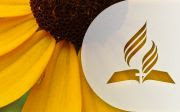 The new gateway spire over West Jerusalem
The new gateway spire over West JerusalemAs I type, it is Saturday night in Jerusalem and Vonnie and I have just had a wonderful Sabbath. It's hard to believe that I had the privilege of sharing a few thoughts at Advent House this morning for the English congregation. The President of the Israel Field, Elder Elofer, was with me on the platform, just hours before he and his wife would fly off to three meetings in both North and South America.
After a lovely luncheon, Vonnie and I drove in our rental car to the Israel Museum and the Shrine of the Book. There we had the great privilege of seeing several chapters of the original scroll of Isaiah found in a cave above Qumran, one of the Dead Sea Scrolls found in 1947. No cameras were allowed, so it will just be stories from us.

Let's go back to Tell es-Safi, however. Friday was the last day for any activity. A large helium balloon provided a platform for the remote control camera and last pictures were taken. It was a blessing from God that everything went as scheduled, for we arrived in Jerusalem earlier than planned, and were able to get our rental car before they closed for Sabbath!
But it was hard to say good-bye to our new friends from around the world. Will we see them again? We had many invitations to return, including from the director, Aren Maeir. It would take some special planning to make that happen, and at this time seems unlikely. But . . .
On the last day of the dig at Area E, our Early Bronze excavations allowed an amazing find to be preserved. The previous week, some bones were discovered to be "articulated", meaning they were connected to other bones in the right places. At first our leader thought it would prove to be a pig, a big wild boar from 4,500 - 5,000 years ago. Then some teeth were discovered that indicated it was a herbivore, so it seemed it might be a big sheep. Only when the zoologist arrived on the last day of excavation did he reveal that it was from the horse family, or the equid family. Microscopic analysis will reveal whether it was really a horse, a wild ass,
 or a donkey.
or a donkey.Apparently horses were just being domesticated and ridden on the steppes of Russia at this early time. In fact, horses don't show up in Egypt (what? no chariots?) until 200 years later!
One of the curiosities that will be explored and reported is whether this burial has any relationship with other finds of ancient horses/asses/donkeys in the Levant. What does it mean? Why would someone bury this animal? Did they normally eat any such animals, but bury this one whole? Why was it arranged in death as it was?
Archaeology is full of mysteries and hypotheses. It was always fun to listen in on discussions of what this or that means.

For the whole tell, this was an interesting but minor find. Much more within the target of the dig were the finds of wonderful pottery untouched since the buildings were destroyed during the Iron Age, during the time of some of King David's descendents.
2 Kings 12:17 Then Hazael king of Aram went up and fought against Gath and captured it, and Hazael set his face to go up to Jerusalem. 18 And Jehoash king of Judah took all the sacred things that Jehoshaphat and Jehoram and Ahaziah, his fathers, kings of Judah, had dedicated, and his own sacred things and all the gold that was found among the treasuries of the house of the LORD and of the king's house, and sent them to Hazael king of Aram. Then he went away from Jerusalem.
Sunday we drive to Jericho, Qumran, and Lake Kinnerett (Sea of Galilee). And many from Milton and BMV Churches are enjoying the Church Campout at Camp Elkanah. We will all have stories to share!






No comments:
Post a Comment